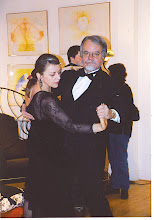 Man with baby, from the series "Buffalo's Lower West Side," 1972
Man with baby, from the series "Buffalo's Lower West Side," 1972Refusing to be silenced by the House Un-American Activities Committee in the 1950s, Mr. Rogovin turned to photography in his quest for social justice. A champion of the working class, Milton Rogovin (born 1909) has photographed people around the world for the past 40 years, focusing on men and women at work and in their homes. His dignified portraits of workers speak of the dreams and aspirations common to humanity.
Influenced by the work of Lewis Hine and Paul Strand, Mr. Rogovin began his interest in photography by documenting Buffalo's African American storefront churches. He captured the transitory nature of the buildings used for religious services and the emotion of the church services. Later photographs document working-class individuals in a six-block neighborhood of Buffalo's lower west side, home to Puerto Ricans, African Americans, Native Americans and other ethnic groups. He began this series in 1972, and rephotographed many of the same people in 1984 and again in 1992, providing a portrait of families over time. In addition, he has documented Native Americans on reservations in New York state, an around-the-world survey of miners and their families, steelworkers before and after plant closings, teenage pregnancy, and the Yemeni community of Lackawanna, N.Y.
Mr. Rogovin is a recipient of the prestigious W. Eugene Smith Award for humanistic photography. His photographs have appeared in dozens of periodicals, such as The New York Times Magazine, Photographers International, Aperture and Creative Camera. Mr. Rogovin's work has been published in several monographs, including The Forgotten Ones, Windows That Open Inward: Images of Chile, with poems by Nobel Prize winner Pablo Neruda; Portraits in Steel, with interviews by Michael Frisch, and Triptychs: Buffalo's Lower West Side Revisited. His work is in the collections of more than 20 institutions, including the Metropolitan Museum of Art, the Museum of Modern Art, the International Museum of Photography at the George Eastman House and the J. Paul Getty Center. Mr. Rogovin's photographs have been widely exhibited, including one-man shows at the Albright-Knox Gallery (Buffalo), the Art Institute of Chicago, the Brooklyn Museum and the Smithsonian's National Museum of American History.
Below, woman with child, from the series "Chile," 1967; bottom, Man in steel plant, from the series "Working People," 1978-79.

The Library's collection of the life's work of Mr. Rogovin consists of more than 1,200 black-and-white photographs selected and printed by the photographer, and all of the 120mm negatives and contact sheets made during Mr. Rogovin's long photographic career. Additional material includes correspondence pertaining to his photographic travels and exhibitions, as well as correspondence with W.E.B. DuBois, Pablo Neruda, Stephen Jay Gould, Robert Coles and other notables.
 The Rogovin collection strengthens the Library's outstanding collection of documentary photography, which includes Lewis Hine's extensive photographic documentation for the National Child Labor Committee, the archives of the Farm Security Administration/Office of War Information and Ansel Adams's photographs of a Japanese relocation camp at Manzanar, Calif. The Rogovin Collection will be available for use after it is processed.
The Rogovin collection strengthens the Library's outstanding collection of documentary photography, which includes Lewis Hine's extensive photographic documentation for the National Child Labor Committee, the archives of the Farm Security Administration/Office of War Information and Ansel Adams's photographs of a Japanese relocation camp at Manzanar, Calif. The Rogovin Collection will be available for use after it is processed.